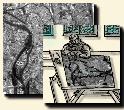 |
 |
![]()
The experiment is based on a P+XS image (three bands of 10m resolution). The algorithm can also be applied on XS SPOT images (20m resolution) by altering some parameter values.
On the first and second bands, built up areas appear as heterogeneous regions, made of small rectangles (buildings). The size of these rectangles is about one to sixteen pixels. Because of the diversity of the materials used in the making of the buildings and the nature of the ground, the gray level of these rectangles can be the same as the non-urban one. So to extract the built up areas with the use of these two bands, we must be able to identify a building from its shape (small rectangle).
As first and second bands are very correlated, the second band (better contrast) is only used (Figure 60).
 |
On the third band (Figure 61), the urban areas appear as small homogeneous regions delimited by dark straight lines. Those lines are thoroughfares that separate building groups and which are composed of:
 |
The urban regions fixed by thoroughfares will be named ``urban districts''.
A dense urban area is made of buildings divided by numerous narrow streets, whereas a ``non dense'' urban area is made of groups of buildings only divided by wide streets, roads, railways or rivers. Thus, the urban density can be defined as the density of narrow streets inside an urban district.
This property cannot be used to define a measure of urban density with the help of the first and second band because the streets cannot be properly extracted on these bands. But this property can be considered on the third band on which the street pixels and the thoroughfares appear as dark straight lines of one to three pixels of thickness.
The center of the city appears darker than the suburbs because of the
distance between streets and the resolution of the image. So, the urban
density will be defined on the third band (Figure 61).